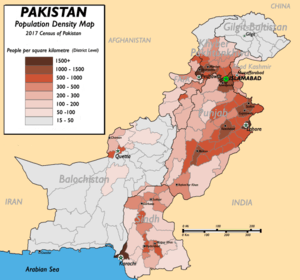Census in Pakistan
The Census in Pakistan (Urdu: مردم شماری پاکستان), is a decennial census and a descriptive count of Pakistan's population on Census Day, and of their dwellings, conducted and supervised by the Pakistan Bureau of Statistics.[2] The 2017 Census in Pakistan marks the first census to take place in Pakistan since 1998.[3]
| Pakistan Census مردم شماری پاکستان | |
|---|---|
| Location(s) | Plot #21, Mauve Area, G-9/1, Islamabad Pakistan 44080 |
| Country | |
| Inaugurated | 1951 (age 68–69) |
| Previous event | March 14, 2017 |
| Next event | 2027 |
| People | Asif Bajwa[1] Chief Statistician/Chief Census Commissioner |
| Website | www |
Overview
A national census is mandated by the Constitution of Pakistan to be held every ten years.[4][5] After the independence of Pakistan in 1947, the first census took place in 1951 under Finance Minister Sir Malik Ghulam, serving under Prime Minister Liaquat Ali Khan.[6] Since 1951, there have been only 6 nationwide censuses (1961, 1972, 1981, 1998 and 2017). Delays and postponements have often been due to politicization. Pakistan's last completed census took place in 2017. The next national census was scheduled to take place in 2001 and later 2008,[7][8] and again in 2010, but none of those plans could materialize.[9] There were multiple census counts completed for the latest round in April 2012,[10][11] but were subsequently thrown out as being "unreliable". A UN led census was to be conducted with staff training and GPS digitisation.[12] As of 2015, the population of Pakistan is estimated at 191.71 million.[13][14] As of 2016, the population of religious minorities in Pakistan have increased to 3 million.[15] On August 25, 2017, the official results declared Pakistan's population to be 207.74 million.[16]

.
Census
1951
According to 1951 census, the Dominion of Pakistan (both West and East Pakistan) had a population of 75 million, in which West Pakistan had a population of 33.7 million and East Pakistan (today Bangladesh) had a population of 42 million.[17][18] In 1951, Hindus constituted 12.9% of the Pakistani population (this includes East Pakistan, today Bangladesh), which made the Dominion of Pakistan the country with the world's second largest Hindu population after India. In the 1951 census, the population of West Pakistan was 1.6% Hindu, while East Pakistan (today Bangladesh) was 22% Hindu. The overall population of West Pakistan was 2.9% non-Muslim, while East Pakistan (today Bangladesh) was 23.2% non-Muslim.[19] After the Partition of India in 1947, two-thirds of the Muslims resided in Pakistan (both West and East) and the remaining third resided in India.[20]
1961
According to the 1961 census, the population of Pakistan was 93 million, with 42.8 million residing in West Pakistan and 50 million residing in East Pakistan.[17][18][18] The literacy was 19.2%, in which East Pakistan had a literacy rate of 21.5% while West Pakistan had a literacy rate of 16.9%.[21] Hindus in East Pakistan were 18.4%[19]
1972
The scheduled 1971 census was postponed due to the political crisis of 1970 followed by the Indo-Pakistani War of 1971 and subsequent loss of East Pakistan.[22][23] In 1970, the population was 65 million in the East Pakistan and 58 million in West Pakistan.[24]
According to the 1972 census, the population of Pakistan was 65.3 million.[25][26] After 1972, the Census Organization was merged into the Ministry of Interior.[27]
1981
According to the 1981 census, the population of Pakistan was 83.783 million.
1998
According to the 1998 census, the population of Pakistan was 132,352,279.[28] however non Muslim population increased to 3.75%.
2017
According to the 2017 census official results, declared on August 25, 2017, the population of Pakistan was 207,774,520.Religious data on this census is yet to be revealed.[29][16]
2027
The seventh national census is scheduled to take place in 2027.
References
- "Chief Statistician/Chief Census Commissioner, PBS | Pakistan Bureau of Statistics". www.pbs.gov.pk. Chief Statistician, Govt. of Pakistan. Retrieved 16 March 2017.
- "Population Census". www.pbs.gov.pk. Islamabad, Pakistan: Pakistan Bureau of Statistics. Retrieved 16 March 2017.
- "Pakistan, Let's Talk About Sex".
- "Why the census is important for Pakistan".
- [Article 9] in PART II of Fourth Schedule: Federal Legislative List of Constitution of Pakistan.
- "Population count: NADRA records cannot substitute for census, says Ravi Pinjani".
- "Plan to hold census in 2008: Cabinet okays F-16 purchase". dawn.com.
- "The census that may reveal too much?".
- "Population, housing census in Pakistan after Eid". Pakistan Times. Archived from the original on 19 July 2011. Retrieved 23 November 2013.
- uzairakhan. "Pakistan's population up by 46.9 per cent since 1998". dawn.com.
- "Pak population increased by 46.9% between 1998 and 2011". The Times of India.
- "The Government of Pakistan, Statistics Division in collaboration with UN-Habitat and UNFPA reaffirm their support for the forthcoming Census". ReliefWeb.
- "Population, Labour Force and Employment PAKISTAN ECONOMIC SURVEY 2014–15" (PDF).
- "PAKISTAN ECONOMIC SURVEY 2014–15 -GOVERNMENT OF PAKISTAN MINISTRY OF FINANCE".
- Minorities’ vote bank reaches close to 3m
- "PROVISIONAL SUMMARY RESULTS OF 6TH POPULATION AND HOUSING CENSUS-2017 | Pakistan Bureau of Statistics | 6th Population and Housing Census". www.pbs.gov.pk. Archived from the original on 30 October 2017. Retrieved 27 August 2017.
- "Migration from East Pakistan(1951–1961)" (PDF).
- http://www.pbs.gov.pk/sites/default/files/other/pocket_book2006/2.pdf
- D'Costa, Bina (2011), Nationbuilding, Gender and War Crimes in South Asia, Routledge, pp. 100–, ISBN 978-0-415-56566-0
- "Muslims in Indian army".
- "East Wing beats West Wing in literacy rate".
- "Why a census counts".
- "Population survey: PM gives green light for sixth census".
- "When East overtakes West".
- "2.1 Population of Pakistan" (PDF).
- "Census & labour data".
- "Population Census Pakistan".
- "Population and Housing Indicators".
- "Enumerating Pakistan".
| Wikimedia Commons has media related to Censuses in Pakistan. |